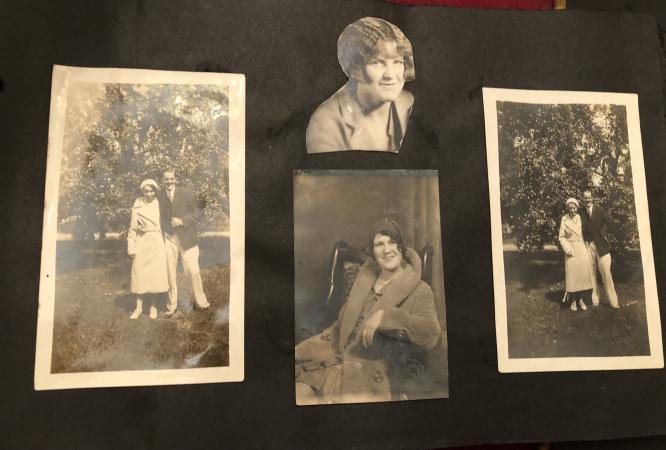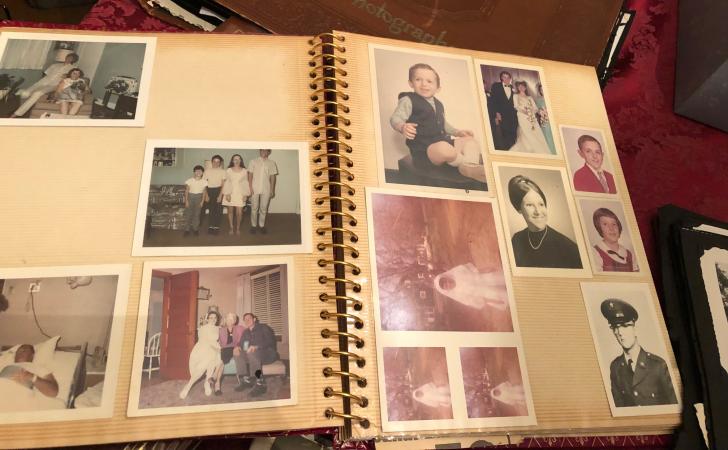Home for the holidays? How we celebrate the winter holidays may be a bit different this year, yet it is still a good time to be thinking about getting a better handle on those family and personal archives, especially if multiple generations of relatives are gathered in one place, whether in-person or via a screen. Here are some tips to get started, inspired by my experience assessing and preserving my own family’s historical records.
Tip #1 Move your archives to a stable environment
One of the most important (and easiest) ways to increase the life of your family’s historical records is to remove them from some of the typical places they end up—attic and basement storage. Keep materials like paper, photographs, bound volumes, and audiovisual material out of storage environments where extreme temperatures and lack of/too much moisture are common and can rapidly change during the year. Storing archival materials in a location where temperature and humidity levels fluctuate is more destructive than keeping them in an environment where the temperature and relative humidity levels are more stable—such as the environmentally controlled areas of your home. For most archival material, being stored at or around 50% relative humidity is best. This simple act can go a long way towards preventing or delaying many kinds of deterioration for a variety of materials. Also be sure to keep your family’s collection away from any sources of moisture or sunlight, which can respectively lead to mold growth or the fading of inks and dyes on photographs and documents.
Tip #2 Label your stuff!
Even if you don’t have all the information about the ‘who’, ‘what’, ‘where’, and ‘why’ of family archival materials, it’s important to capture what you can. A family member in possession of records can take for granted their knowledge and memory when it comes to providing descriptive information. It is so crucial when preserving family history to externalize that knowledge by accurately labelling important documents, photographs, audiovisual materials, and other items so future generations will know who and what they’re looking at! Use a soft graphite pencil when writing descriptive information directly onto archival records, applying minimum pressure and writing only on the back-side edges to prevent indentation. Pens and markers can bleed through to the front side and accelerate deterioration of the material, plus pencil can easily be corrected in case mistakes are made. Another option, if you think descriptions are going to get particularly wordy, is to number your documents, photographs, and other items and provide a corresponding description on an additional sheet of paper.

Tip #3 When labeling photographs, spell out individuals’ names, birth/death dates, and the date the photo was taken.
Completing a good descriptive caption for a photograph often begins with identifying the date, which could be known down to the specific day, or estimated based on the photographic format used and contextual clues like peoples’ clothing and hair styles. Obviously having additional information is best, but identifying a time frame is one of the easiest bits of information to capture. Even providing a year, date range, decade, etc. is a huge help in increasing a photograph’s meaning to family history.
Identifying the individuals in photographs by name, as well as the location the photo was taken, greatly increases the usefulness of photographs for genealogy purposes. If you are working with family members to identify individuals, be sure to capture a person’s entire name: first name, surname, and any known nicknames they may have went by. Names are often reused in multiple generations of a family, so identifying the middle name as well as birth/death dates can be helpful. The reason for being so thorough is that while family members who knew the individuals in real life may find it easy to recall a name, that is not always the name on the person’s birth certificate. Spelling it all out in a description will help future generations verify individuals when tracing family genealogy.
Tip #4 Throw out duplicate prints – but keep the negatives.
Remember those one-hour photo places that gave great deals on making multiple copies of prints? At the time it probably seemed like quite the bargain, but in some cases, all those second and third and fourth sets of Uncle Jerry’s birthday party in 1972 have just been sitting in drawers and unnecessarily taking up space. Archivists recommend keeping at most two copies of historical materials. Don’t hesitate to toss blurry or severely under/over-exposed photographs as well. If you feel uncomfortable throwing away any photos, consider providing a set to a relative that would appreciate them. This can also be a good preservation strategy as having copies in different geographic locations can prevent loss caused by natural disasters, house fires, etc.
It may also be wise to hold on to negatives that were usually provided by the developer with their corresponding prints. If my family’s photos are any proof, most times people will keep the prints and negatives in the original envelope they came in from the photo developer. Negatives are the original source image and contain the most information in terms of level of detail. If you foresee possibly digitizing your photos for posterity, it’s a good idea to hold onto the negatives.
Tip #5 – Remove bulky fasteners
Binder clips, paper clips, rubber bands, staples—we all are used to seeing fasteners as a way to organize documents in our daily lives. But all those fasteners are not great when it comes to long-term preservation. Rubber bands become brittle, stick to documents, and cause surface stains. Metal fasteners can easily rust, take up large amounts of space in storage containers, and cause permanent indentations on paper.
A quick and easy way to increase the longevity of your family archival materials is by removing some of these fasteners. This shouldn’t be done wholesale though. Focus mainly on the large fasteners that take up a lot of space, such as binder clips, and those that are actively causing deterioration, such as rubber bands and rusty paper clips. It’s best to avoid taking out staples as the delicate process of removing them, if not done carefully, can cause additional damage to the paper and usually isn’t worth the risk. As the deterioration staples cause is relatively minimal and they do not add much to a collection’s bulk, it’s usually best to leave them alone.

Once you’ve removed the bulky fasteners, you’re not quite done yet. Maintaining the intellectual relationships within and between documents is important and can now be done using archival housing materials. Large packets of papers can be placed into file folders with appropriate descriptions on the folder tabs. For smaller documents, fold a large piece of acid-free paper in half and sandwich the documents you wish to preserve within this subfolder. This action not only replaces the role of the fastener in keeping documents together, but also can be used to isolate certain documents that may be deteriorating more rapidly and can cause damage to the materials around them, such as newspaper clippings.

Tip #6 – Proceed with caution when creating albums and scrapbooks
Making a nice, pretty scrapbook or photo album to pass on as an heirloom can be pretty tempting, but the kinds of paper stocks, adhesives, and plastics used in scrapbooks and albums are typically of inferior quality, and at worst dangerous, when compared to archival-quality and acid-free folders, sleeves, and containers. Adhesives and plastic sheets that were typical of commercial scrapbook and album kits for decades are now known to accelerate deterioration of photos and documents, including sticking to the emulsions of photos and leaving permanent adhesive residue that can discolor archival materials. Sometimes photographs or other items that have been included in a scrapbook become so bonded to a page that it is safer to leave the materials as they are, as trying to force their removal may cause severe damage.

Instead, a better and safer way to preserve historically significant materials would be to house photographs in archival-quality sleeves, which can then be placed in an archival clamshell binder that can act as an album cover. Important historical documents should be flattened and housed in acid-free and well-labelled archival folders. Trust me, your descendants will thank you.
See below for more tips from the Archives staff on establishing and preserving your family archives!
RELATED RESOURCES
- “Quick Tips for Preserving Your Family’s Past,” by Alison Reppert Gerber, The Bigger Picture, Smithsonian Institution Archives
- “Family Memories at Thanksgiving,” by Pamela M. Henson, The Bigger Picture, Smithsonian Institution Archives
- “Thanks(giving) for the memories – a preservation family project,” by Nora Lockshin, The Bigger Picture, Smithsonian Institution Archives
Produced by the Smithsonian Institution Archives. For copyright questions, please see the Terms of Use.

Leave a Comment